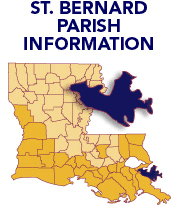St. Bernard Parish - What HappenedAlthough officially determined to be a Category 3 hurricane, Katrina produced a Category 5 surge and winds in excess of 125 mph when it made landfall in St. Bernard Parish. As the storm surge traveled across On Sept. 24, an eight-foot storm surge from Hurricane Rita breached recently-repaired levees, and combined with between 6 and 12 inches of rain, again caused widespread flooding in the parish. In all, 127 St. Bernard citizens died, about 68,000 people were displaced, and 100 percent of the parish housing stock (over 25,000 units), were either destroyed or damaged sufficiently to make them uninhabitable. All parish businesses and government buildings, and most utility systems, were similarly damaged or destroyed. Damaged levees, decimated wetlands, and the still-open MRGO have left the parish vulnerable to future storms. |







